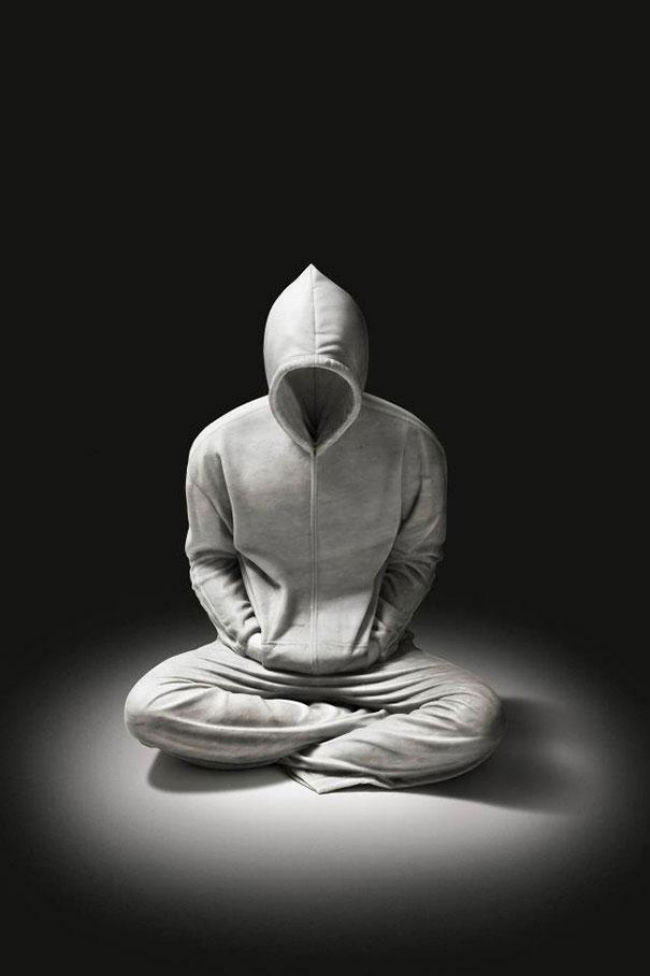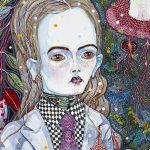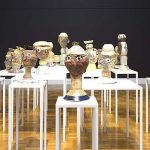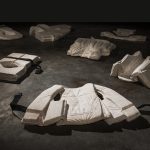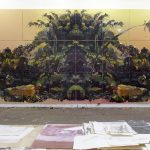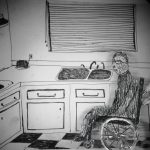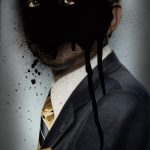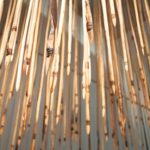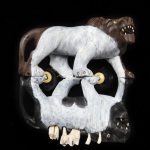Before heading south for this year’s Adelaide Biennial I saw Opera Australia’s production of Tchaikovsky’s Eugene Onegin. Pushkin’s famous character is the archetypal ‘dark heart’. Onegin humiliates the young Tatiana, who has confessed her love for him. He plays a nasty joke on his best friend, and keeps going long after he should have stopped. He kills the same friend in a duel, even though he knows he is to blame for the argument. Onegin is a strange mixture of selfishness and self-loathing. Despite his tragic demeanour, he simply can’t stop himself from being a bastard. Is there any trace of this in the much-vaunted Australian character?
When Nick Mitzevich, the fearless director of the Art Gallery of South Australia, took the reins of this year’s Adelaide Biennial of Australian Art, and called it ‘Dark Heart’, he knew it would cause tremors. Over the years South Australia has developed a reputation for dark and brutal deeds, from the Snowtown murders to animal massacres. Nobody in Adelaide wants to talk about these things, but Mitzevich brings them to mind with his provocative title.
Naturally, this is not his stated rationale. In explaining the theme Mitzevich refers to a quotation from that canonical source, Robert Hughes: “The basic project of art is always to make the world whole and comprehensible, to restore it to us in all its glory and its occasional nastiness, not through argument but through feeling, and then to close the gap between you and everything that is not you, and in this way pass from feeling to meaning.”
This is a magnificent sentence but it speaks of art in the most generalised fashion. It is more to the point, however, than a confusing and largely irrelevant catalogue essay by Ross Woodrow, which assigns the Biennial artists some special role in advancing “aesthetics” in Australian art. As art and aesthetics are inseparable terms it’s hard to know what he is trying to say. If one had to identify art that makes much of its own “aesthetics”, it would be abstract, minimal and conceptual work, which is hardly represented in this Biennial.
There are other ideas that are equally bizarre, such as the claim that a print by Kathe Kollwitz is guilty of “moral duplicity”. I could go on listing poorly argued or dubious claims, but it would only be a detour from the art.
The important point to make about this Biennial is that it is not about “aesthetics”, it is about spectacle. Dark Heart is a consummate piece of showmanship by a director/curator who understands how to make contemporary art accessible to the broadest possible audience.
By including approximately 30 artists, or groups of artists, Mitzevich has not tried to ramp up the numbers to make the show sound more impressive. He has not tried to uncover new geniuses, being content to include many of the most fashionable artists in Australia. In most cases he has commissioned new works rather than fall back on familiar and successful pieces.
The use of dark walls and spotlighting in the downstairs galleries owes a debt to David Walsh’s Museum of Old and New Art in Hobart. Walsh has made it acceptable to inject a little theatre into art exhibitions, and Mitzevich was quick to learn the lesson. He needed no lessons when it comes to hanging a show. The travelling Turner exhibition looked exceptional in Adelaide last year, and the Biennial is also beautifully installed.

When a show gets the fundamentals right it tends to cover over the deficiencies of individual works. Every artist has been given the most generous space and the most sympathetic presentation. On entering the exhibition one is confronted with an enormous painting by Del Kathryn Barton called The heart land. The work is filled with her trademark dream-like, polysexual imagery, with every plane loaded with busy patterning. Even the artist might struggle to tell us what it all means.
Barton has become a polarizing figure in art circles, with an audience that divides into “love it” and “hate it” camps. Much of the argument centres around whether these works are as obsessive-compulsive as they appear, or contrived and self-conscious. I tend to the former position, although I’m not sure I’d like to be staring at one of these pictures all day. In the centre of this squirming composition is a female figure turned upside-down, with lines leading directly into the heart.
It acts as a signpost for the show that follows.
The skill of Mitzevich’s hang lies not merely in the space allotted to individual works, but to some memorable juxtapositions. Alongside two large, soft sculptures woven by Dani Marti from black PVC, there are five small prints from Goya’s series, Los Caprichos. This not only reminds us of Marti’s Spanish roots, but makes his work seem more menacing and surreal.
A collection of Brendan Huntley’s ceramic heads is placed within sight of a wall of Sidney Nolan portraits from the permanent collection. The two bodies of work eye each off with curiosity and suspicion. It’s a meeting between two generations. One sees Huntley’s deliberately de-skilled heads – somewhere between portraits and utilitarian vessels – as a perfect match for Nolan’s attempt to paint with the freedom of a child.
Even more potent was the decision to exhibit works by Alex Seton and Ben Quilty in the same room. Although these pieces were conceived and executed independently, they gain a new dimension when placed in close proximity. Seton’s work is called Someone died trying to have a life like mine. It consists of a series of life jackets carved from white marble, scattered across the floor. The reference is to 28 life jackets that washed up on the shore of the Cocos Islands in May 2103.
Instead of preserving life, these jackets would send the wearer to the bottom of the sea. The work is elegiac in nature – as redolent of death as a field of tombstones. I can’t remember the last time I saw an artwork that made so powerful a political gesture in such an understated manner.
Quilty’s large painting, The Island, is based on a 19th century painting of the Gordon River, Tasmania, by Haughton Forrest. It may have been intended to allude to the dispossession of the indigenous people and the exploitation of the land, but in this new context the picture takes on a vivid resemblance to Arnold Böcklin’s Isle of the Dead (1880) – an iconic painting that found its way into thousands of European homes in print form. The image echoes the funereal aspect of Seton’s sculptures, and also makes us think of the other islands, from the Cocos Islands to Manus Island. Our viewpoint is from the sea, as we swim towards this looming mass, wondering if we will ever reach shore.
Equally moving, in a more intimate manner, is Richard Lewer’s Worse luck… I am still here, an animated film that tells the true story of Herbert Erickson, an elderly man from Perth, who assisted his bed-ridden wife to commit suicide, and failed in his own attempt to join her. The drawings are crude, but it’s a mesmeric study of love, loss and pain.
Politics re-surfaces in Tony Garifalakis’s Mob Rule, a suite of black-and-white photographs of world leaders, their faces obliterated by smears of black ink, in which the eyes are still visible. Kevin Rudd is here, ironically transformed into a ‘faceless man’. The best, though, is Vladimir Putin, who bears an uncanny resemblance to Batman’s old enemy, the Riddler. It may be a one-liner, but Garifalakis alludes to the anonymity of power, the decisions made by a handful of strangers that influence the lives of every human being.
Dark Heart would not be credible without a strong indigenous component, and here Mitzevich has made some acute choices. The urban aspect is represented by a riotous installation of transformed Aboriginalia by Tony Albert, and a suite of antique images of tribal life, reprinted on gold foil by Brook Andrew. Meanwhile the Kulata Tjuta Project has produced an installation of carved spears made by men of the Amata community. Suspended from the ceiling, densely packed together, the spears serve as an aggressive reminder of the continuity of traditional culture.
Finally, there is a gigantic painting made by Martu women from Central Australia. The process of painting, and the landscape from which it springs, were captured by video artist, Lynette Wallworth, who travelled to the community with the singer, Anthony, of Anthony and the Johnsons, and spent ten days living with the artists.

There is a lot to like about this show, which has thrown down the gauntlet to the forthcoming Sydney Biennale. Although I can only discuss a few works, it would be criminal not to mention Fiona Hall’s Off of my tree, a show-stealing installation in a humorous Gothic vein, so packed with objects and allusions it would require another column just to make an inventory. The artist is offering no explanations or excuses. She says this is her response to the increasing craziness of the world.
Dark Heart: The 2014 Adelaide Biennial
Art Gallery of South Australia, until 11 May.
Published in the Sydney Morning Herald, Saturday 15 March, 2014

